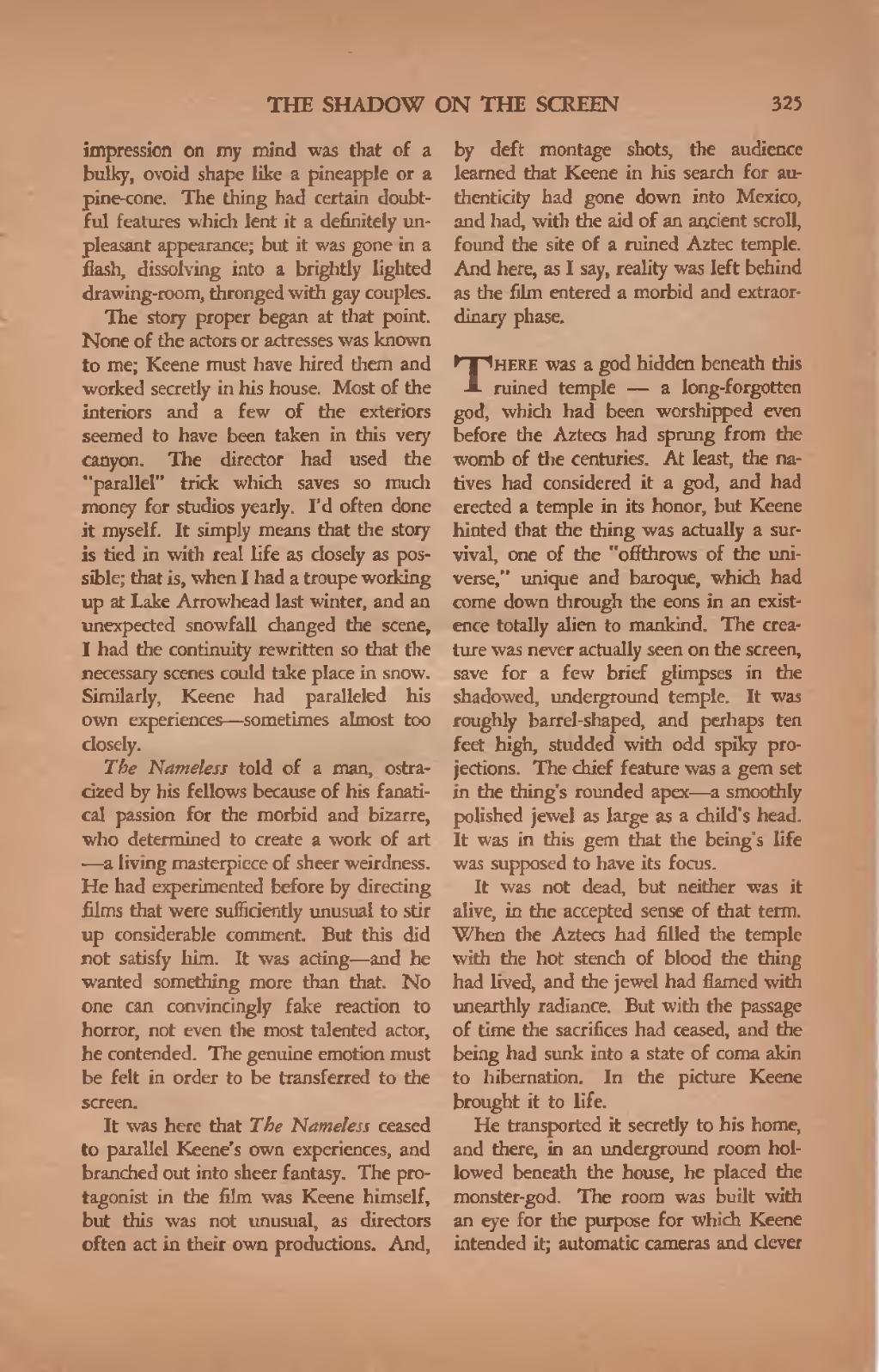impression on my mind was that of a bulky, ovoid shape like a pineapple or a pine-cone. The thing had certain doubtful features which lent it a definitely unpleasant appearance; but it was gone in a flash, dissolving into a brightly lighted drawing-room, thronged with gay couples.
The story proper began at that point. None of the actors or actresses was known to me; Keene must have hired them and worked secretly in his house. Most of the interiors and a few of the exteriors seemed to have been taken in this very canyon. The director had used the "parallel" trick which saves so much money for studios yearly. I'd often done it myself. It simply means that the story is tied in with real life as closely as possible; that is, when I had a troupe working up at Lake Arrowhead last winter, and an unexpected snowfall changed the scene, I had the continuity rewritten so that the necessary scenes could take place in snow. Similarly, Keene had paralleled his own experiences—sometimes almost too closely.
The Nameless told of a man, ostracized by his fellows because of his fanatical passion for the morbid and bizarre, who determined to create a work of art—a living masterpiece of sheer weirdness. He had experimented before by directing films that were sufficiently unusual to stir up considerable comment. But this did not satisfy him. It was acting—and he wanted something more than that. No one can convincingly fake reaction to horror, not even the most talented actor, he contended. The genuine emotion must be felt in order to be transferred to the screen.
It was here that The Nameless ceased to parallel Keene's own experiences, and branched out into sheer fantasy. The protagonist in the film was Keene himself, but this was not unusual, as directors often act in their own productions. And, by deft montage shots, the audience learned that Keene in his search for authenticity had gone down into Mexico, and had, with the aid of an ancient scroll, found the site of a ruined Aztec temple. And here, as I say, reality was left behind as the film entered a morbid and extraordinary phase.
There was a god hidden beneath this ruined temple—a long-forgotten god, which had been worshipped even before the Aztecs had sprung from the womb of the centuries. At least, the natives had considered it a god, and had erected a temple in its honor, but Keene hinted that the thing was actually a survival, one of the "offthrows of the universe," unique and baroque, which had come down through the eons in an existence totally alien to mankind. The creature was never actually seen on the screen, save for a few brief glimpses in the shadowed, underground temple. It was roughly barrel-shaped, and perhaps ten feet high, studded with odd spiky projections. The chief feature was a gem set in the thing's rounded apex—a smoothly polished jewel as large as a child's head. It was in this gem that the being's life was supposed to have its focus.
It was not dead, but neither was it alive, in the accepted sense of that term. When the Aztecs had filled the temple with the hot stench of blood the thing had lived, and the jewel had flamed with unearthly radiance. But with the passage of time the sacrifices had ceased, and the being had sunk into a state of coma akin to hibernation. In the picture Keene brought it to life.
He transported it secretly to his home, and there, in an underground room hollowed beneath the house, he placed the monster-god. The room was built with an eye for the purpose for which Keene intended it: automatic cameras and clever
